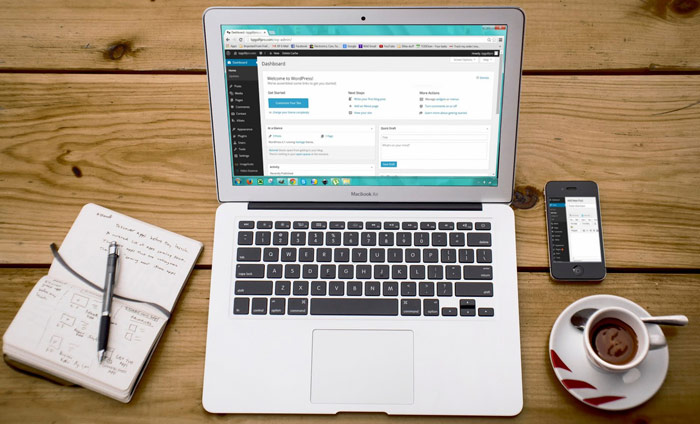Today, there’s no other platform out there that provides endless customization the way WordPress does. Its user-friendliness and accessibility make WordPress the most popular platform for web developers and publishers, both.

In a world that’s evolving every second, it’s crucial to stay on your toes. Regardless of how small-scale your website is, there will come the point where you’ll have to redesign it to ensure it stays fresh.
Thus, when the time comes, there are a few things you need to keep in mind before you initiate the entire process. And by things, I’m talking important, impossible-to-miss features that could make or break the growth of your business.
Without further delay, here are a few top-notch tips for redesigning your existing WordPress website:
Plan for The Future
Every successful business owner will tell you one thing: don’t plan for the short-run. Instead, set your goals for the long-run.
Even if you’re looking to design a simple 5-page website, the growth of your business is something that should always be on your mind. What does this mean exactly? Well, always leave room for future redesigning.
Whatever features you incorporate should reflect the fact that there might be changes later. Not only does this make your work much easier in the future, but you can easily add new elements, such as room for a blog or new products, a few years down the lane.
In a case where you’re considering different templates, there’s a vast variety of WordPress themes to cater to your needs and requirements.
Incorporate Eye-Catching Graphics and Visuals
Many people make the mistake of thinking that a website redesign only involves minor changes such as new icons, background graphics, or even a new logo. However, experts know that it’s much more than that.
A website redesign needs to involve a better visual presence for your brand. It doesn’t just include the elements mentioned above, but it also involves awesome product photos, exciting videos, and other interesting visual content, such as infographics.
Why is this so important? Well, simply put, people respond to strong visual content. You don’t need strong visual content just to draw attention; you need it to convey so many other things as well.
Imagine yourself in the shoes of your potential customer: would you trust a website that just has stock photos of products and customers, or one that has generic pictures? There’s no question: the latter, of course.
Customers can easily tell when something’s generic and when it’s not. Visitors spend more time on websites that have detailed product photos; in fact, over seventy-five percent of e-commerce shoppers say product photos determine whether they’ll make a purchase or not. E-commerce businesses, in particular, can explore different e-commerce plugins that WordPress has to offer.
Strong visual elements also attract more visitors to your website. An article that’s accompanied by images is more likely to be shared on social media than one that doesn’t. Additionally, repurposing your images for social media marketing leads to higher engagement too.
Have Dedicated Landing Pages
Let’s get a little technical now. Do you know what a landing page is? Well, a landing page is a page on your website that’s dedicated to providing a single offer and call-to-action (CTA). Landing pages work in a very to-the-point way, which makes them an effective tool to measure the responses of different offers, designs, and marketing communications.
During the website redesign process, it’s not important for you to make drastic changes to your website since you’re only concerned with individual landing pages. You should also familiarize yourself with different landing page trends to ensure you’re not missing anything.
Depending on the industry you’re working in, landing pages can lead to conversion rates of one to three percent. In fact, using videos on your landing pages can shoot up conversion rates by eighty-six percent.
Personalize Your Website
Many business-owners are under the misconception that they need to do exactly what their competitors are doing and this thought process translates into their redesign strategy too with identical websites. What they don’t realize is that there’s a missed opportunity regarding personalization.
Perhaps the primary reason personalization is so important is because that’s what customers want. Seventy-four percent of customers get frustrated when websites’ content doesn’t match their interests. Moreover, forty-six percent of B2B customers believe personalization is the way to build and maintain relationships with business providers.
Apart from this, though, personalization has the power to grow your business. By 2020, personalization can potentially increase your profits by fifteen percent.
However, just because your website’s personalized, doesn’t mean every user gets a unique experience. The user experience can be modeled according to a particular characteristic, such as gender, and you can draft marketing messages accordingly.
In fact, your approach to personalization doesn’t necessarily need to be complicated, expensive, or technical. To start, develop landing pages for every referral source, target demographic, or major location.
Don’t Stray Away from Your Brand
Lastly, your website redesign shouldn’t feel alien to your users. In simpler terms, it needs to represent your brand.
Every business out there aims to leave a footprint and create a brand. The look and feel of your website should fall in line with the message you’re trying to convey through other marketing materials.
Still confused? Let me explain further.
When I refer to the look of a website, I’m talking about its visual elements. It’s crucial for the color scheme to match the colors of your logo and various other marketing materials to ensure there’s no disconnect with overall communications. Furthermore, the product photos you use on your website should be the same as the ones you use elsewhere to display your products.
On the other hand, the feel refers to the user experience. This includes various factors, such as performance, accessibility, and how users feel when interacting with your website.
These tips are essential for anyone looking to redesigning their WordPress website. Do you have any other tips in mind? Or have you already tried some of these before? Let us know in the comments below!
About the author:



